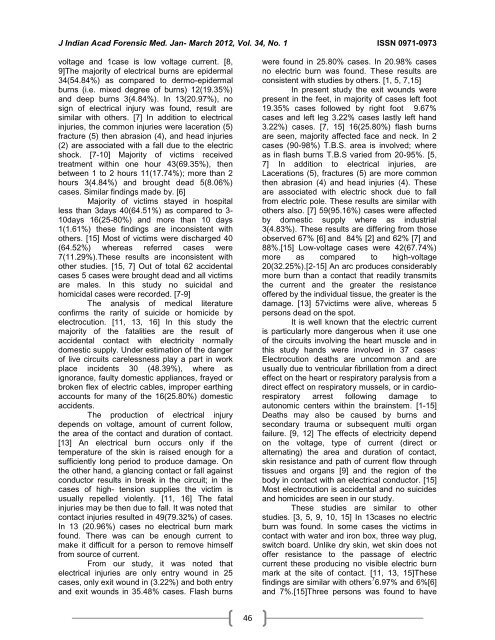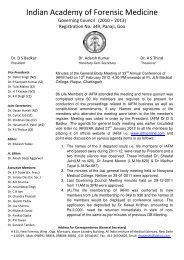Indian Academy of Forensic Medicine (IAFM) - Official website of IAFM
Indian Academy of Forensic Medicine (IAFM) - Official website of IAFM
Indian Academy of Forensic Medicine (IAFM) - Official website of IAFM
You also want an ePaper? Increase the reach of your titles
YUMPU automatically turns print PDFs into web optimized ePapers that Google loves.
J <strong>Indian</strong> Acad <strong>Forensic</strong> Med. Jan- March 2012, Vol. 34, No. 1 ISSN 0971-0973<br />
voltage and 1case is low voltage current. [8,<br />
9]The majority <strong>of</strong> electrical burns are epidermal<br />
34(54.84%) as compared to dermo-epidermal<br />
burns (i.e. mixed degree <strong>of</strong> burns) 12(19.35%)<br />
and deep burns 3(4.84%). In 13(20.97%), no<br />
sign <strong>of</strong> electrical injury was found, result are<br />
similar with others. [7] In addition to electrical<br />
injuries, the common injuries were laceration (5)<br />
fracture (5) then abrasion (4), and head injuries<br />
(2) are associated with a fall due to the electric<br />
shock. [7-10] Majority <strong>of</strong> victims received<br />
treatment within one hour 43(69.35%), then<br />
between 1 to 2 hours 11(17.74%); more than 2<br />
hours 3(4.84%) and brought dead 5(8.06%)<br />
cases. Similar findings made by. [6]<br />
Majority <strong>of</strong> victims stayed in hospital<br />
less than 3days 40(64.51%) as compared to 3-<br />
10days 16(25-80%) and more than 10 days<br />
1(1.61%) these findings are inconsistent with<br />
others. [15] Most <strong>of</strong> victims were discharged 40<br />
(64.52%) whereas referred cases were<br />
7(11.29%).These results are inconsistent with<br />
other studies. [15, 7] Out <strong>of</strong> total 62 accidental<br />
cases 5 cases were brought dead and all victims<br />
are males. In this study no suicidal and<br />
homicidal cases were recorded. [7-9]<br />
The analysis <strong>of</strong> medical literature<br />
confirms the rarity <strong>of</strong> suicide or homicide by<br />
electrocution. [11, 13, 16] In this study the<br />
majority <strong>of</strong> the fatalities are the result <strong>of</strong><br />
accidental contact with electricity normally<br />
domestic supply. Under estimation <strong>of</strong> the danger<br />
<strong>of</strong> live circuits carelessness play a part in work<br />
place incidents 30 (48.39%), where as<br />
ignorance, faulty domestic appliances, frayed or<br />
broken flex <strong>of</strong> electric cables, improper earthing<br />
accounts for many <strong>of</strong> the 16(25.80%) domestic<br />
accidents.<br />
The production <strong>of</strong> electrical injury<br />
depends on voltage, amount <strong>of</strong> current follow,<br />
the area <strong>of</strong> the contact and duration <strong>of</strong> contact.<br />
[13] An electrical burn occurs only if the<br />
temperature <strong>of</strong> the skin is raised enough for a<br />
sufficiently long period to produce damage. On<br />
the other hand, a glancing contact or fall against<br />
conductor results in break in the circuit; in the<br />
cases <strong>of</strong> high- tension supplies the victim is<br />
usually repelled violently. [11, 16] The fatal<br />
injuries may be then due to fall. It was noted that<br />
contact injuries resulted in 49(79.32%) <strong>of</strong> cases.<br />
In 13 (20.96%) cases no electrical burn mark<br />
found. There was can be enough current to<br />
make it difficult for a person to remove himself<br />
from source <strong>of</strong> current.<br />
From our study, it was noted that<br />
electrical injuries are only entry wound in 25<br />
cases, only exit wound in (3.22%) and both entry<br />
and exit wounds in 35.48% cases. Flash burns<br />
46<br />
were found in 25.80% cases. In 20.98% cases<br />
no electric burn was found. These results are<br />
consistent with studies by others. [1, 5, 7,15]<br />
In present study the exit wounds were<br />
present in the feet, in majority <strong>of</strong> cases left foot<br />
19.35% cases followed by right foot 9.67%<br />
cases and left leg 3.22% cases lastly left hand<br />
3.22%) cases. [7, 15] 16(25.80%) flash burns<br />
are seen, majority affected face and neck. In 2<br />
cases (90-98%) T.B.S. area is involved; where<br />
as in flash burns T.B.S varied from 20-95%. [5,<br />
7] In addition to electrical injuries, are<br />
Lacerations (5), fractures (5) are more common<br />
then abrasion (4) and head injuries (4). These<br />
are associated with electric shock due to fall<br />
from electric pole. These results are similar with<br />
others also. [7] 59(95.16%) cases were affected<br />
by domestic supply where as industrial<br />
3(4.83%). These results are differing from those<br />
observed 67% [6] and 84% [2] and 62% [7] and<br />
88%.[15] Low-voltage cases were 42(67.74%)<br />
more as compared to high-voltage<br />
20(32.25%).[2-15] An arc produces considerably<br />
more burn than a contact that readily transmits<br />
the current and the greater the resistance<br />
<strong>of</strong>fered by the individual tissue, the greater is the<br />
damage. [13] 57victims were alive, whereas 5<br />
persons dead on the spot.<br />
It is well known that the electric current<br />
is particularly more dangerous when it use one<br />
<strong>of</strong> the circuits involving the heart muscle and in<br />
this study hands were involved in 37 cases ,<br />
Electrocution deaths are uncommon and are<br />
usually due to ventricular fibrillation from a direct<br />
effect on the heart or respiratory paralysis from a<br />
direct effect on respiratory mussels, or in cardiorespiratory<br />
arrest following damage to<br />
autonomic centers within the brainstem. [1-15]<br />
Deaths may also be caused by burns and<br />
secondary trauma or subsequent multi organ<br />
failure. [9, 12] The effects <strong>of</strong> electricity depend<br />
on the voltage, type <strong>of</strong> current (direct or<br />
alternating) the area and duration <strong>of</strong> contact,<br />
skin resistance and path <strong>of</strong> current flow through<br />
tissues and organs [9] and the region <strong>of</strong> the<br />
body in contact with an electrical conductor. [15]<br />
Most electrocution is accidental and no suicides<br />
and homicides are seen in our study.<br />
These studies are similar to other<br />
studies. [3, 5, 9, 10, 15] In 13cases no electric<br />
burn was found. In some cases the victims in<br />
contact with water and iron box, three way plug,<br />
switch board. Unlike dry skin, wet skin does not<br />
<strong>of</strong>fer resistance to the passage <strong>of</strong> electric<br />
current these producing no visible electric burn<br />
mark at the site <strong>of</strong> contact. [11, 13, 15]These<br />
findings are similar with others 7 6.97% and 6%[6]<br />
and 7%.[15]Three persons was found to have









